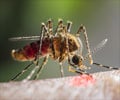When infected with Zika virus, brain tumor cells form metabolites such as digoxin, a molecule that kills glioblastoma (brain cancer) cells.
Highlights
- Zika virus could eliminate the effects of glioblastoma (brain tumor) and leave only the viral particles that synthesize digoxin.
- Digoxin could be the key molecule that activates glioblastoma cell death during Zika infection.
- The virus could be an alternative for the treatment of glioblastoma, which is highly resistant to chemotherapy drugs.
Through the mass spectrometry analysis of Zika virus-infected glioblastoma cells, scientists also identified the presence of digoxin, a molecule which induced the death of tumoral cells of skin and breast cancer in previous experiments.
Zika Virus Infects human neural progenitor cells (hNPCs)
Previous research conducted recently in Brazil and elsewhere points to increased mortality rates for human neural progenitor cells (hNPCs) infected by Zika virus, as well as growth inhibition and morphological abnormalities.
Alterations in these cells, which are precursors of brain cells and become cortical neurons in embryos and fetuses, may be a cause of microcephaly in babies whose mothers have been infected by Zika. Other studies have shown that the virus is capable of moving into brain cells, modifying the regulation of the cell cycle, and inducing their death.
The results of the analysis showed that the glioblastoma cells displayed moderate cytopathic effects 24 hours after infection, such as rounded, swollen cell bodies and formation of syncytia, masses of cytoplasm in which the membrane contains several nuclei.
"The cytopathic effects of Zika infection on glioblastoma cells were observed most clearly after 48 hours. Cell morphology was almost totally altered during this period," Catharino said.
The research team analyzed the cells using matrix-assisted laser desorption/ionization mass spectrometry imaging (MALDI-MSI to identify the main compounds (metabolites) produced by glioblastoma cells during infection by Zika.
The mass spectrometry data were submitted to statistical analysis, which showed that 24 hours after infection, the cells began to produce cardiac glycosides, especially digoxin.
Metabolites Produced By Zika Kills Cancer Cells
Previous in vitro studies conducted by researchers in other countries showed that this molecule was able to reduce the multiplication and increase the mortality of cells from melanoma, the most aggressive type of skin cancer, as well as breast cancer and neuroblastoma, a tumor that typically affects patients aged 15 or younger.
Because digoxin and other cardiac glycosides have been shown to induce cancer cell death, the researchers concluded that infection by Zika triggered synthesis of the molecule in glioblastoma cells and that this phenomenon is probably one of the factors that lead to neuronal cell death. "Digoxin could be the key molecule that activates glioblastoma cell death during Zika infection," Catharino said.
Based on these findings, the researchers suggest that a genetically engineered Zika virus could eliminate the effects of infection and leave only the viral particles that synthesize digoxin. Thus, the virus could be an alternative for the treatment of glioblastoma, which is highly resistant to chemotherapy drugs.
"The use of oncolytic viruses [viruses genetically engineered to destroy tumor cells] is at an advanced stage, especially to treat skin cancer and myeloma [bone marrow cancer]," Catharino said. "Zika could be a candidate for the treatment of glioblastoma."
Reference
- Estela de O. Lima, Tatiane M. Guerreiro, Carlos Fernando O.R. Melo, Diogo N. de Oliveira, Daisy Machado, Marcelo Lancelloti, Rodrigo R. Catharino. ’MALDI imaging detects endogenous digoxin in glioblastoma cells infected by Zika virus—Would it be the oncolytic key?’ Journal of Mass Spectrometry (2018). http://dx.doi.org/10.1002/jms.4058.
Source-Medindia
















